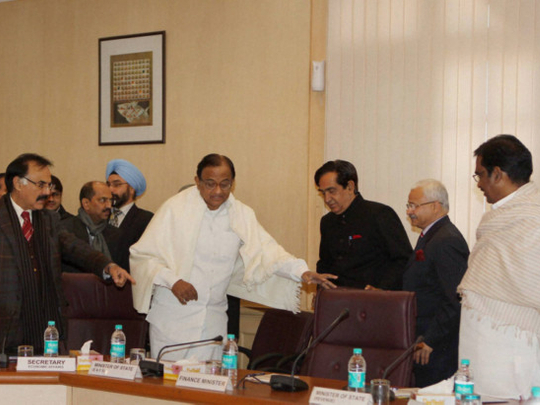
New Delhi: India’s record current-account deficit threatens to weigh on the rupee and curb the magnitude of interest-rate cuts forecast to begin this month in support of government policies seeking faster growth.
The shortfall swelled to $22.31 billion (Dh81.8 billion) in the quarter ended September 30, the widest in Reserve Bank of India data beginning 1949. The rupee is down 6.1 per cent against the dollar in the past three months, fanning price gains that will limit Governor Duvvuri Subbarao to a 25 basis-point rate cut on January 29, according to eight of 10 analysts in a Bloomberg News survey.
India has the biggest deficit among the largest emerging markets, stoked by the worst export slump since the 2009 global recession and gold imports that Finance Minister Palaniappan Chidambaram said are a “huge drain.” Trade and budget gaps have increased economic risks, the Reserve Bank said December 28, even as the government tries to lure more foreign investment and limit subsidies as Asia’s No 3 economy struggles.
Threats
“The widening current-account deficit indicates very severe macroeconomic threats,” said Rupa Rege Nitsure, an economist at Bank of Baroda in Mumbai. “The central bank has less room to ease policy meaningfully.”
Subbarao has left borrowing costs at 8 per cent since a 50 basis-point cut in April 2012, resisting Chidambaram’s calls in October for a further reduction.
Still, the central bank signalled in a statement of the December 18 policy review that it may ease in 2013 as an inflation rate exceeding 7 per cent cools. Two analysts in the Bloomberg survey predicted a 0.5 percentage-point cut in January.
The rupee weakened 1.1 per cent, the most in two months, to 55.075 per dollar at the 5pm close in Mumbai. The BSE India Sensitive Index climbed 0.1 per cent. Five-year interest rate swaps advanced to 7.16 per cent, the highest in more than a week, while the one-year rate rose as high as 7.6 per cent, indicating investors pared bets on the extent of cuts in borrowing costs.
The deficit in the current account, which tracks goods, services and investment income, reached 5.4 per cent of gross domestic product in July-to-September.
Exports slid for seven months through November. Gold imports accounted for more than two-thirds of the current-account gap on average in the last three years, the central bank said in its Financial Stability report last month. India also purchases about 80 per cent of its crude oil from overseas.
Rupee outlook
The rupee will weaken about 7 per cent to 59 per dollar by year-end, according to Nomura Holdings Inc. Kotak Mahindra Bank Ltd predicts a drop to as low as 57 per dollar this quarter.
Prime Minister Manmohan Singh curbed fuel subsidies in September and opened industries including retail to more foreign investment, seeking to steady the currency, revive growth and avert a credit-rating downgrade that may disrupt capital inflows.
The current-account deficit may narrow as 2013 progresses, which, along with an acceleration in the economy, could “give the central bank room to ease policy” later in the year, said Sujan Hajra, a Mumbai-based economist at Anand Rathi Financial Services Ltd.












